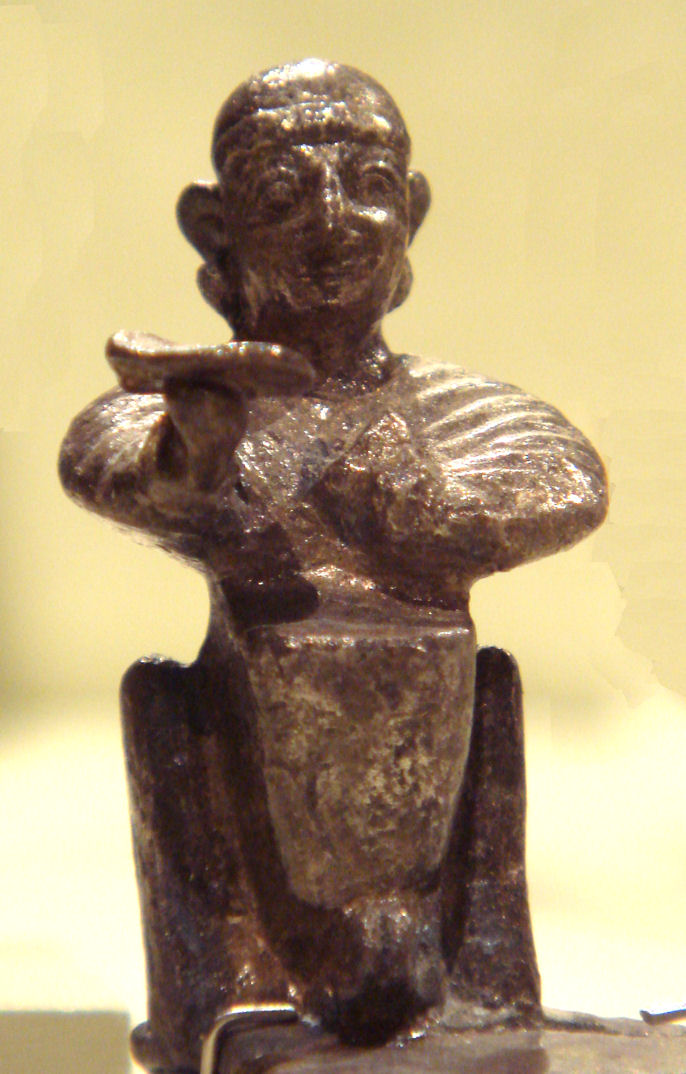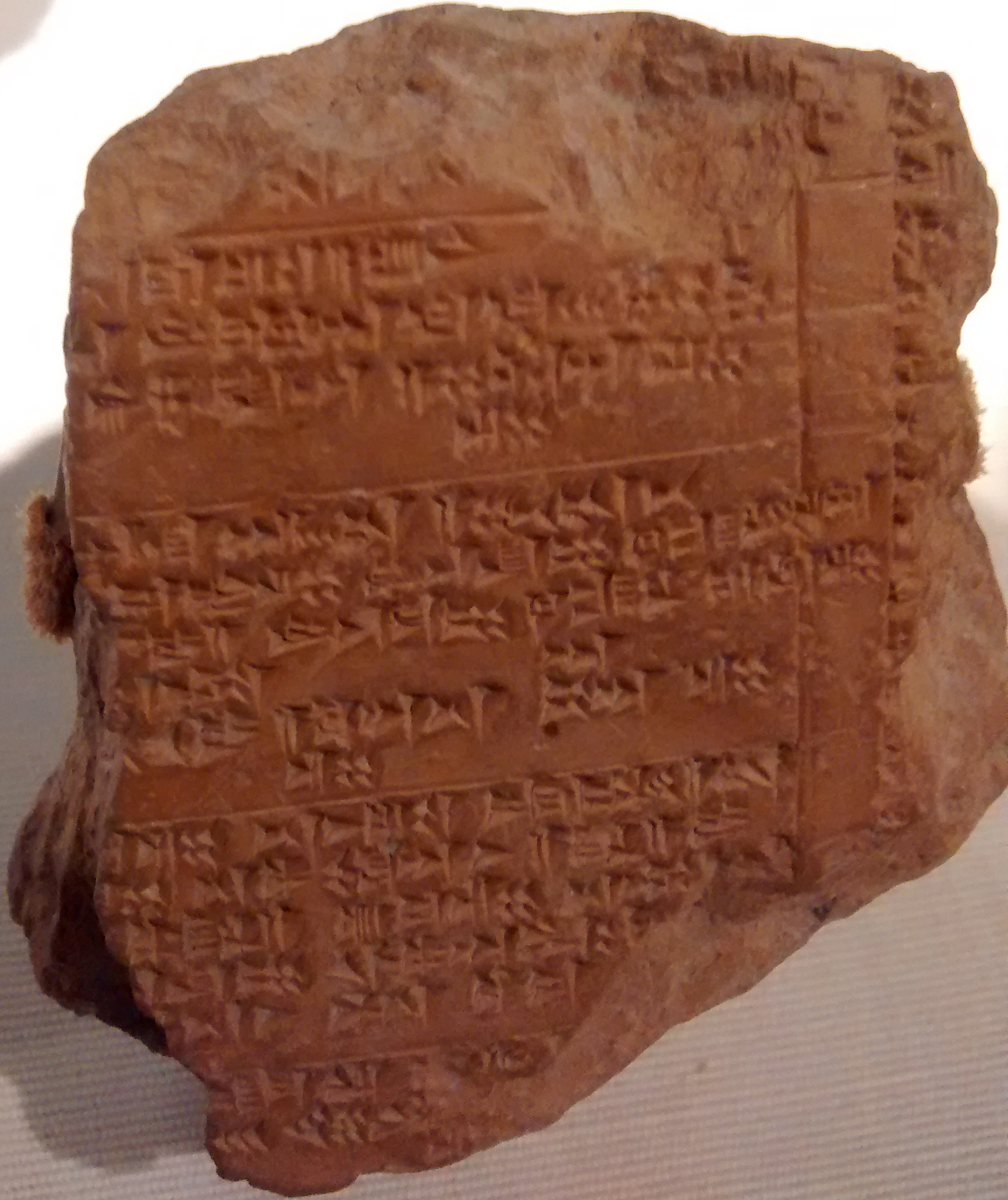|
Hittite Military Oath
The Hittite military oath ( CTH 427) is a Hittite text on two cuneiform tablets. The first tablet is only preserved in fragments (KBo XXI 10, KUB XL 13, and minor fragments), the second tablet survives in three copies, and can be restituted almost completely. The oldest copy (KUB XL 13) is fragmentary, but two younger copies (KUB XL 16, KBo VI 34) are well preserved. Description The text is in Old Hittite, with some scribal errors of the later copyists, and prescribes the oath to be taken by military commanders. More precisely, it describes a series of symbolic actions intended to represent the afflictions that should befall the oath-takers should they break their word. On one occasion, for example, women's clothing, a spindle and an arrow is brought before those swearing their allegiance. The arrow is broken, and they are told that should they break their oath, their weapons should likewise be broken, and they should be made women and given women's tasks. Then, a blind and ... [...More Info...] [...Related Items...] OR: [Wikipedia] [Google] [Baidu] |
Hittite Chariot
Hittite may refer to: * Hittites, ancient Anatolian people ** Hittite language, the earliest-attested Indo-European language ** Hittite grammar ** Hittite phonology ** Hittite cuneiform ** Hittite inscriptions ** Hittite laws ** Hittite religion ** Hittite music ** Hittite art ** Hittite cuisine ** Hittite navy ** Hittite kings ** Hittite sites ** Hittite studies * Syro-Hittite states, Iron Age states located in modern Turkey and Syria * Biblical Hittites, also known as the "Children of Heth" * Hittite Microwave Corporation, a former semiconductor manufacturer now owned by Analog Devices See also * *Hatti (other) *Hattush (other) *Hattian (other) *Hattic (other) {{disambiguation Language and nationality disambiguation pages ... [...More Info...] [...Related Items...] OR: [Wikipedia] [Google] [Baidu] |
Indo-European Languages
The Indo-European languages are a language family native to the northern Indian subcontinent, most of Europe, and the Iranian plateau with additional native branches found in regions such as Sri Lanka, the Maldives, parts of Central Asia (e.g., Tajikistan and Afghanistan), Armenia, and areas of southern India. Historically, Indo-European languages were also spoken in Anatolia. Some European languages of this family—English language, English, French language, French, Portuguese language, Portuguese, Russian language, Russian, Spanish language, Spanish, and Dutch language, Dutch—have expanded through colonialism in the modern period and are now spoken across several continents. The Indo-European family is divided into several branches or sub-families, including Albanian language, Albanian, Armenian language, Armenian, Balto-Slavic, Celtic languages, Celtic, Germanic languages, Germanic, Hellenic languages, Hellenic, Indo-Iranian languages, Indo-Iranian, and Italic languages, ... [...More Info...] [...Related Items...] OR: [Wikipedia] [Google] [Baidu] |
Military Oaths
A military, also known collectively as armed forces, is a heavily armed, highly organized force primarily intended for warfare. Militaries are typically authorized and maintained by a sovereign state, with their members identifiable by a distinct military uniform. They may consist of one or more military branches such as an army, navy, air force, space force, marines, or coast guard. The main task of a military is usually defined as defence of their state and its interests against external armed threats. In broad usage, the terms "armed forces" and "military" are often synonymous, although in technical usage a distinction is sometimes made in which a country's armed forces may include other paramilitary forces such as armed police. Beyond warfare, the military may be employed in additional sanctioned and non-sanctioned functions within the state, including internal security threats, crowd control, promotion of political agendas, emergency services and reconstruction, pro ... [...More Info...] [...Related Items...] OR: [Wikipedia] [Google] [Baidu] |
Hurrian Mythology
The Hurrian religion was the polytheistic religion of the Hurrians, a Bronze Age people of the Near East who chiefly inhabited the north of the Fertile Crescent. While the oldest evidence goes back to the third millennium BCE, it is best attested in cuneiform sources from the second millennium BCE written not only in the Hurrian language, but also Akkadian, Hittite and Ugaritic. It was shaped by contacts between the Hurrians and the various cultures with which they coexisted. As a result, the Hurrian pantheon included both natively Hurrian deities and those of foreign origin, adopted from Mesopotamian, Syrian (chiefly Eblaite and Ugaritic), Anatolian and Elamite beliefs. The culture of the Hurrians was not entirely homogeneous, and different local religious traditions are documented in sources from Hurrian kingdoms such as Arrapha, Kizzuwatna and Mitanni, as well as from cities with sizeable Hurrian populations, such as Ugarit and Alalakh. Hurrian religion forms one of the be ... [...More Info...] [...Related Items...] OR: [Wikipedia] [Google] [Baidu] |
Hittite Mythology
Hittite mythology and Hittite religion were the religious beliefs and practices of the Hittites, who created an empire centered in Anatolia from . Most of the narratives embodying Hittite mythology are lost, and the elements that would give a balanced view of Hittite religion are lacking among the tablets recovered at the Hittite capital Hattusa and other Hittite sites. Thus, "there are no canonical scriptures, no theological disquisitions or discourses, no aids to private devotion". Some religious documents formed part of the corpus with which young scribes were trained, and have survived, most of them dating from the last several decades before the final burning of the sites. The scribes in the royal administration, some of whose archives survive, were a bureaucracy, organizing and maintaining royal responsibilities in areas that would be considered part of religion today: temple organization, cultic administration, reports of diviners, make up the main body of surviving te ... [...More Info...] [...Related Items...] OR: [Wikipedia] [Google] [Baidu] |
Tudḫaliya IV
Tudḫaliya IV was a king of the Hittite Empire (New kingdom), and the younger son of Ḫattušili III. He reigned –1215 BC (middle chronology) or –1209 BC (short chronology). His mother was the great queen, Puduḫepa. Early life Tudḫaliya was likely born in his father's court in Ḫattuša, after his brother and crown prince Nerikkaili, but still while their father was governing on his brother Muwatalli II's behalf. He was a good friend of Muwatalli's son, Kurunta, and Ḫattušili ordered that they stay on good terms. After Ḫattušili III as King wrote up a treaty with "Ulmi-Tessup" which confirmed Kurunta's rule over Tarḫuntašša, Ḫattušili elevated Tudḫaliya over his older brother to be his crown prince. Tudḫaliya as king drew up a bronze tablet treaty confirming the links between him and Kurunta. Tudḫaliya had a sister, Maathorneferure, who served as Great Royal Wife to Pharaoh Ramesses II of Egypt. Reign The Hittite Empire covered large parts of ... [...More Info...] [...Related Items...] OR: [Wikipedia] [Google] [Baidu] |
Arnuwanda I
Arnuwanda I was a Hittite great king during the early 14th century BC, ruling in c. 1390–1380/1370 BC. Origins Arnuwanda's parents are unknown. Because both Arnuwanda and his wife, Queen Ašmu-Nikkal, are described on their respective seals as the children of Tudḫaliya II (sometimes called Tudḫaliya I or I/II), this was long interpreted as a marriage between siblings. This, however, was clearly forbidden by Hittite custom and law, and it is now generally agreed that while Ašmu-Nikkal was indeed the daughter of Tudḫaliya II, Arnuwanda was only his son-in-law and possibly adoptive son, as the daughter's ''antiyant'' husband, an acceptable heir in the absence of a son. Association on the throne with Tudḫaliya II Arnuwanda I began his reign in association with his father-in-law and predecessor, Tudḫaliya II, perhaps for as many as a dozen years or so. The simultaneous attestation of both men as great king indicates an association on the throne, something unusual in Hit ... [...More Info...] [...Related Items...] OR: [Wikipedia] [Google] [Baidu] |
Simile
A simile () is a type of figure of speech that directly ''compares'' two things. Similes are often contrasted with metaphors, where similes necessarily compare two things using words such as "like", "as", while metaphors often create an implicit comparison (i.e. saying something "is" something else). However, there are two schools of thought regarding the relationship between similes and metaphors. The first defines them as opposites, such that a statement cannot be both a simile and a metaphor — if it uses a comparison word such as "like" then it is a simile; if not, it is a metaphor. The second school considers metaphor to be the broader category, in which similes are a subcategory — according to which every simile is also a metaphor (but not vice-versa). These two schools reflect differing definitions and usages of the word "metaphor" and regardless of whether it encompasses similes, but both agree that similes always involve a direct comparison word such as "like" or "as". ... [...More Info...] [...Related Items...] OR: [Wikipedia] [Google] [Baidu] |
Hittite Texts
The corpus of texts written in the Hittite language consists of more than 30,000 tablets or fragments that have been excavated from the royal archives of the capital of the Hittite Kingdom, Hattusa, close to the modern Turkish town of Boğazkale or Boğazköy. While Hattusa has yielded the majority of tablets, other sites where they have been found include: Maşat Höyük, Ortaköy, Kuşaklı or Kayalıpınar in Turkey, Alalakh, Ugarit and Emar in Syria, Amarna in Egypt. The tablets are mostly conserved in the Turkish museums of Ankara, Istanbul, Boğazkale and Çorum (Ortaköy) as well as in international museums such as the Pergamonmuseum in Berlin, the British Museum in London and the Musée du Louvre The Louvre ( ), or the Louvre Museum ( ), is a national art museum in Paris, France, and one of the most famous museums in the world. It is located on the Rive Droite, Right Bank of the Seine in the city's 1st arrondissement of Paris, 1st arron ... in Paris. The corp ... [...More Info...] [...Related Items...] OR: [Wikipedia] [Google] [Baidu] |
Kušuḫ
Kušuḫ, also known under the name Umbu, was the god of the moon in Hurrian pantheon. He is attested in cuneiform texts from many sites, from Hattusa in modern Turkey, through Ugarit, Alalakh, Mari and other locations in Syria, to Nuzi, located near modern Kirkuk in Iraq, but known sources do not indicate that he was associated with a single city. His name might be derived from the toponym Kuzina, possibly the Hurrian name of Harran, a city in Upper Mesopotamia, but both this etymology and identification of this sparsely attested place name remain uncertain. He was a popular, commonly worshiped god, and many theophoric names invoking him are known. In addition to serving as a divine representation of the moon, he was also associated with oaths, oracles and pregnancy. Some aspects of his character were likely influenced by his Mesopotamian counterpart Sin, while he in turn was an influence on the Ugaritic god Yarikh and Luwian Arma. In Hurrian mythology, Kušuḫ appe ... [...More Info...] [...Related Items...] OR: [Wikipedia] [Google] [Baidu] |
Išḫara
Išḫara was a goddess originally worshipped in Ebla and other nearby settlements in the north of modern Syria in the third millennium BCE. The origin of her name is disputed, and due to lack of evidence supporting Hurrian or Semitic etymologies it is sometimes assumed it might have originated in a linguistic substrate. In Ebla, she was considered the tutelary goddess of the royal family. An association between her and the city is preserved in a number of later sources from other sites as well. She was also associated with love, and in that role is attested further east in Mesopotamia as well. Multiple sources consider her the goddess of the institution of marriage, though she could be connected to erotic love as well, as evidenced by incantations. She was also linked to oaths and divination. She was associated with reptiles, especially mythical '' bašmu'' and ''ḫulmiẓẓu'', and later on with scorpions as well, though it is not certain how this connection initially devel ... [...More Info...] [...Related Items...] OR: [Wikipedia] [Google] [Baidu] |




